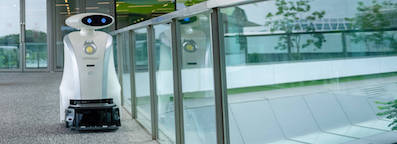 Cleanzine: your weekly cleaning and hygiene industry newsletter 26th June 2025 Issue no. 1168
Cleanzine: your weekly cleaning and hygiene industry newsletter 26th June 2025 Issue no. 1168
Your industry news - first
The original and best - for over 20 years!
We strongly recommend viewing Cleanzine full size in your web browser. Click our masthead above to visit our website version.
Cobotics, a real step change for the cleaning and hygiene industry
 The cobot Leobot, a collaborative robot that works side-by-side with cleaning operatives, won the Amsterdam Innovation Award 2020. Out of a total of 86 submissions in four different categories, it was a cobot that took the prize home.
The cobot Leobot, a collaborative robot that works side-by-side with cleaning operatives, won the Amsterdam Innovation Award 2020. Out of a total of 86 submissions in four different categories, it was a cobot that took the prize home.
What makes this innovation so unique and what does cobotics mean for the future of the cleaning and hygiene industry? In this article, Interclean’s brand marketing manager, Hilke de Vries, helps us to dive into the world of cobotics.
But first, what are cobots?
“Cobots are smart and autonomous robots that perform repetitive tasks that would otherwise be performed by cleaning operatives. With the arrival of cobots, cleaning operatives are now able to focus on more specialised and skilled work. The collaboration between human and cobot increases overall satisfaction, efficiency and productivity.
The big difference with robots, and thus we call them cobots, is that they are designed to operate completely independently. Robots are often set up separately, shielded from employees for safety reasons. A cobot is often much smaller and lighter than a robot, which is why this one can also be moved. This ensures that cobot can be used more flexibly and work side-by-side with cleaning operatives.
Contrary to popular belief, the cobots are instructed and monitored by people at the job site and are there to support workers. Although the machines are smart and autonomous, personnel performing operations and predictive maintenance remains essential.
What are the benefits of using cobots in the cleaning industry?
A cobot brings cleaning right out into the public arena and makes it highly visible. This raises the profile of the sector which is incredible important. The collaboration between humans and cobots also offers an opportunity to yield cost benefits. In a previous article, we talked about the importance of ergonomic cleaning in our sector, because carrying out cleaning work is physically demanding and cost a lot of energy. Various body parts are therefore used intensively and are therefore at risk of various physical complaints. It is very important for both the employer and the employee that the work can be done as safely and healthily as possible.
The introduction of cobots can relieve cleaning operatives from the stress and mental exhaustion of repetitive work. Cleaners can do more varied and satisfying work and have the satisfaction of seeing improvements in overall performance. Not only this, but cleaning operatives working with cobots have the ability to engage with and manage the latest cutting edge innovations, allowing them to develop new skills and competencies in some of the most popular areas of technology.
Several parties also see robotisation as a solution for the shortage on the labour market. The Corona crisis may change this temporarily, but due to the aging population, shrinkage of the workforce, the image of cleaning work and the increase of it the level of education of the population, the cleaning sector also has to deal with this shortage. By having simple, repetitive tasks performed by cobots, this can be (partly) resolved.
At the moment, cobots are offered as a service in combination with fixed lease models as opposed to the traditional purchase of the technology itself. This means contractors don't have to make large investments up front, with little certainty about life or long-term value. Instead they will benefit from innovations programs and optimisation efforts of the suppliers to continuously improve the services with a fixed monthly subscription cost.
Cobotics is more than just the technology behind it
Cobotics is a real step change in the industry and will require quite a big behavioural change for the cleaning operatives. It's not just about adding new technology to the everyday work environment, but it requires a new way of thinking and adapting. Robotisation will cause a shift in cleaning activities, where the focus for cleaning operatives will be on more specialised activities instead of repetitive tasks.
It remains to be seen how much the industry will adapt to these new solutions. There is still a lot of scepticism about their impact and the costs right now is still a key consideration for most users. This is why we need to re-frame the narrative around automation. We all know that robots will continue to play a greater role in all of our lives. And that's an inevitable development in our sector too. The organisations that seamlessly and harmoniously integrate cobots with cleaning staff into their daily activities will flourish in the coming years.”
To give an example of what a cobot exactly does, two of the three nominated innovations in the category machines for the Amsterdam Innovation Award 2020 are cobots: the Leobot by Lionsbot International and Whiz by ICE Robotics.
26th November 2020







